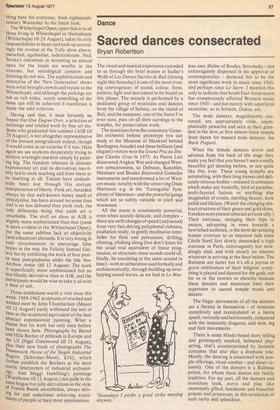Dance
Sacred dances consecrated
Bryan Robertson
The visual and musical experience extended to us through the brief season at Sadler's Wells of Les Danses Sacrees de Bali (closing night this Saturday) is one of the most riveting convergences of sound, colour, form, pattern, light and movement to be found on this planet. The miracle is performed by a dedicated group of musicians and dancers from the village of Sebatu, on the island of Bali, and the company, one of the finest I've ever seen, pass on all their earnings to the temples, for preservation work.
The musicians form the customary GameIan orchestra (whose prototype you can study at the Museum of Mankind behind Burlington Arcade) and these brilliant (and elegant) visitors won the Grand Prix du Disque Charles Gros in 1973. As Pierre Loti discovered Angkor Wat and changed Western consciousness, so Debussy, Koechlin, Messiaen and Boulez discovered Gamelan instruments and transformed a lot of Western music: notably with the unnerving Onde Martenot, e.g. in the `Tarangalila' Symphony of Messiaen — and the powerful gongs which are so subtly variable in pitch and resonance.
All the music is consistently powerful, even when acutely delicate, and complex — there are swift changes of speed (and mood) from very fast-driving polyphonal richness, exaltation really, to gently meditative interludes for flute and percussion, drifting, chiming, clinking along (but don't listen for the usual oral equivalent of linear progression, or structure: these sounds could all, finally, be coexisting at the same second in time)—with reverberation used formally and architectonically, through building up overlapping sound waves, as we find in Le Mar teau sans Maftre of Boulez. Stravinsky — not extravagantly dispersed in his approval of contemporaries — declared this to be the most significant work in music since 1945, and perhaps since Le Sacre. I mention this only to indicate that South East Asian music, has conspicuously affected Western music since 1945— and not merely with superficial exoticism, as in Schmitt, Dukas, etc.
The male dancers, magnificently costumed, are appropriately virile, unemphatically powerful and seen at their grandest in the slow,at first almost itatic temple feast dance for massed male dancers: the .Bans Prajurit.
When the female dancers arrive and advance from the back of the stage they make you feel that you haven't seen a really beautiful girl dancing before, or nor quite like this, ever. These young nymphs are astonishing, with their long tresses and delicately sinuous bodies — encased in costumes which make any butterfly, bird of paradise, multi-layered fuchsia or anything else imaginable of exotic, startling beauty, look pallid and lifeless. (Watch the changing abstract structure of their green and gold skirts. It makes most present abstract art look silly.) Their entrance, swinging their hips in unison, advancing in rows towards a bewitched audience, is the most devastating female overture to us innocent lads since Cecile Sorel first slowly descended a high staircase in Paris, extravagantly but revealingly clad, and with clearly no interest whatever in arriving at the floor below. The Balinese are faster but it's all a joyous or grave celebration of their religion: everything is played and danced for the gods, not for us or the tourists or showbiz because these dancers and musicians limit their repertoire to sacred temple music and dances.
There is some Hindu-based story telling and grotesquely masked, helmeted playacting, that's counterpointed by fantastic costumes that also play a dramatic role. Mostly, the dancing is concerned with temple offerings, ritual combat — and sheer virtuosity. One of the dancers is a Balinese prince, for whom these dances are family tradition. For my part, all the dancers and musicians look, move and play like immensely gifted, handsome and beautiful princes and princesses, in this revelation of such rarity and splendour.


































 Previous page
Previous page